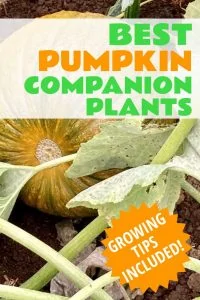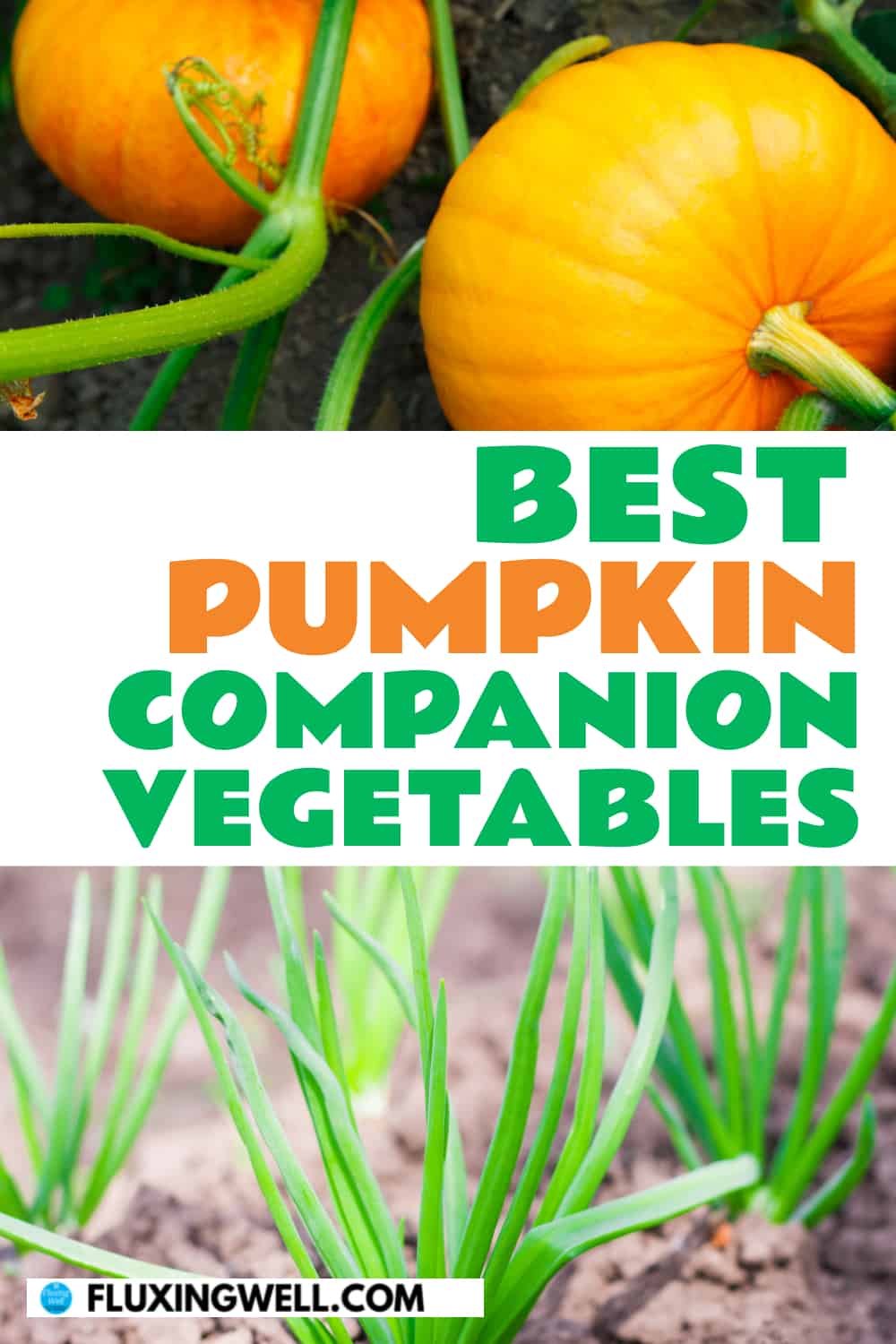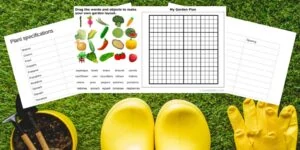Learn how to plant, grow, and harvest pumpkins. What are the best pumpkin companion plants and which should you avoid? What grows best next to pumpkins? What should you not plant near a pumpkin? Will pumpkins choke out other plants? Get the answers to many of your questions about companion planting for pumpkins right here. Whether you are a novice pumpkin grower or a seasoned veteran, you can get a list of the best and worst pumpkin companion plants as well as tips for growing a successful pumpkin crop. Read on to learn what to plant with pumpkins.
Table of Contents
The Pumpkin Planting Backstory in Our Garden
Here in our USDA plant hardiness zone 8b, I have sometimes hesitated to plant pumpkins. Since we often end up with a lot of green tomatoes at the end of our growing season, due to elevation, I worry that pumpkins won’t get very big. I often wonder if pumpkins will appear on the vines, and if they do, will there be very many? Well, I’m going to stop worrying and wondering. This growing season, our pumpkin plant took over the whole lower half of our garden space, overrunning the cucumbers, zucchini, and other squash I had planted in hills. I’m going to have to rethink my planting strategy. (Good thing I have a great interactive garden planner!) What did I plant this year to help the pumpkin plant thrive? In order to replicate the success, I took notes for my garden notebook, did some research, and here are the results.
What Makes a Good Companion Plant?
Why pay attention to companion plants? Why is companion planting for pumpkins beneficial? A good companion plant is one that offers various benefits to its neighboring plants, such as minimizing pest and disease issues, which helps enhance their growth, health, and overall productivity. Here are some key qualities that make a good companion plant that will help you plant strategically to make the most of your yard or garden space:
Pest Control: Companion plants may repel pests or attract beneficial insects that prey on pests, helping to reduce pest damage without the need for chemical pesticides.
Pollinator Attraction: Plants that attract pollinators such as bees, butterflies, and hummingbirds can improve pollination and fruit set in neighboring plants, leading to higher yields.
Soil Improvement: Some companion plants have deep roots that help break up compacted soil, while others fix nitrogen or add organic matter to the soil, improving soil fertility and structure for neighboring plants.
Complementary Growth Habits: Companion plants with different growth habits, such as tall plants providing shade for shorter ones or ground covers suppressing weeds, can maximize space and resources in the garden.
Disease Resistance: Certain companion plants may emit chemicals or compounds that inhibit the growth of pathogens or pests, reducing the risk of disease in neighboring plants.
Seasonal Considerations: Companion plants that thrive during different seasons can provide continuous benefits throughout the year, such as early bloomers attracting pollinators or cover crops protecting soil during the off-season.
Aesthetic Value: Companion plants with attractive foliage, flowers, or fruits can enhance the visual appeal of the garden while providing practical benefits to neighboring plants.
Where is the Best Place to Plant Pumpkins?
Pumpkins do best when planted at the edge of a garden so the plant has room to spread. For best results, amend the soil with a fertilizer like an organic bone meal fertilizer.
Create a mound or hill that is about 3 feet wide, then plant 3 seeds. You could also plant 5 seeds, then thin to the 3 strongest plants, but I often forget the thinning step when I am in the midst of a busy garden season. Many years, since our growing season isn’t very long, I buy a pumpkin plant start. This works especially well when we have a cool, wet, spring, as we had this year. If you plant more than one hill of pumpkins, space the hills about 6 feet apart, if you have the room in your garden. As the vines grow and spread, you can direct them to where you want to go. I had to keep the vines from climbing up a row of hollyhocks this year.
Which Flowers Go Well with Pumpkins?
Can you plant flowers with pumpkins? Yes, there are many types of flowers that make good companion plants for pumpkins. Marigolds, nasturtiums, petunias and sunflowers all attract pollinators. In addition, nasturtiums and petunias help repel pests. Sunflowers can provide a natural support trellis for smaller pumpkin varieties. There are some who advise against planting sunflowers near pumpkins because they might block sunlight, but if you plant the sunflowers on the correct side of the pumpkins (in my case, that would be the north side), the sunlight will not be blocked and you can add sunflowers to your list of a good companion plant for pumpkins after all.

Which Vegetables Go Well with Pumpkins?
Different vegetables are beneficial to plant near pumpkins, and there are a variety of reasons why these vegetables make good pumpkin companion plants. Corn improves soil conditions. Beans and peas fix nitrogen in the soil. Radishes can help loosen the soil. Okra, like sunflowers, can provide small pumpkins with a natural trellis on which to grow. Like sunflowers, you would want to plant the okra in such a way to avoid blocking any sunlight. Garlic, onions, and shallots all help keep pests away.
Which Fruits Go Well with Pumpkins?
Melons make good pumpkin companion plants. They can repel harmful pests and attract earthworms. The earthworms are beneficial because they help aerate the soil. Some gardeners avoid planting melons too close to pumpkins, as melons seek the same nutrients as pumpkins, but if you amend the soil with fertilizer, that should not be a problem.
Which Herbs Go Well with Pumpkins?
Herbs have two main benefits to offer pumpkins. First, they help deter pests, often with their fragrance. Second, they help attract pollinators with their blooms. Basil, borage, chamomile, chives, hyssop, lavender, marjoram, oregano, parsley, rosemary, sage, tansy and thyme fall into the beneficial herbs category. Mint offers pumpkins an additional benefit. It can improve the flavor of pumpkins. If you are growing sugar pumpkins for pie, that’s a great benefit.
What Should You Not Plant Near Pumpkins?
Zucchini and other squash are bad companion plants for pumpkins because they can compete for the same nutrients, so planting too closely together with pumpkins is not recommended. However, as with the melons listed previously in this post, you could amend the soil with fertilizer. If you have limited garden space, you could try that strategy. Beets also compete for the same nutrients as pumpkins. Fennel can inhibit the growth of pumpkin plants. Rhubarb should not be planted near pumpkins, and this is mainly because it is not beneficial to rhubarb. Pumpkins can block too much sunlight, causing the rhubarb plant to suffer. Carrots and potatoes can damage the roots of pumpkins. Cabbage and kale take nutrients away from the soil, so planting them near pumpkins should be avoided.
Quick Pumpkin Companion Plant Reference Chart
Use this pumpkin companion planting chart as a quick reference guide when you are planning your garden layout. You can print it out and put it in a garden journal logbook. (What? You need to make one? Well, good news! I have got you covered.)
| Best Pumpkin Companion Plants |
Worst Pumpkin Companion Plants
|
| Flowers | Beets |
| Marigolds | Cabbage |
| Nasturtiums | Carrots |
| Petunias | Fennel |
| Sunflowers | Kale |
| Vegetables | Potatoes |
| Beans | Rhubarb |
| Corn | Zucchini |
| Garlic | |
| Okra | |
| Onions | |
| Peas | |
| Radishes | |
| Shallots | |
| Fruit | |
| Melons | |
| Herbs | |
| Basil | |
| Borage | |
| Chamomile | |
| Chives | |
| Hyssop | |
| Lavender | |
| Marjoram | |
| Mint | |
| Oregano | |
| Parsley | |
| Rosemary | |
| Sage | |
| Tansy | |
| Thyme |
How Many Pumpkin Plants Do I Need?
If you are growing pumpkins just for your family, you might need just one plant. A typical pumpkin plant will produce between 2-5 pumpkins of the medium-sized variety. Pumpkin plant varieties that produce smaller pumpkins may yield up to 12 pumpkins per plant. If you hope to make money from a u-pick pumpkin patch and have a one-acre plot of land to work with, about 1,000 pumpkins may be produced on an acre of land.
What is the Best Fertilizer for Pumpkins?
Pumpkins prefer sandy soil that is high in organic matter. If you are intent on growing large pumpkins for a contest, you might need to switch up the fertilizers as a plant grows. A good nitrogen-rich fertilizer to start with is Miracle-Gro. Phosphorus-rich bone meal fertilizer is a good choice to give pumpkin plants once flowers begin forming. Finally, to promote healthy pumpkins once they start to form, a potassium-rich fertilizer like potash would be a good choice. You could also spread around some compost if you have some available. Banana peels are especially rich in potassium.
Not interested in competing for the title of biggest pumpkin at your local county fair? If you would rather just apply one type of fertilizer and be done with it, an all-purpose 10-10-10 balanced fertilizer will benefit your pumpkin. It will benefit other plants in your garden as well.
Do Pumpkins Need a lot of Water?
1 inch of water a week is a good standard for pumpkins. How long does it take to water a vegetable garden one inch? Place a container to collect water when you next do your watering. Measure how much is collected after 30 minutes. If it’s a half inch, you know you need to water for one hour to get one inch of water on your garden. If you are using a soaker hose, you could try placing a container partially buried in the dirt.
Pumpkin plants need to be watered deeply, preferably in the mornings. They might need even more on hot afternoons when the pumpkins are developing. Overhead watering should be avoided, if possible, so the leaves don’t rot. If you have to water overhead, just be prepared for the leaves to get white and powdery. Sometimes, you just need to work with what you have. If you have a large garden plot, running soaker hoses might be a challenge. My favorite way to water and keep an eye on what is going on in the garden is to use a watering wand. For some, that might not be practical, but it works especially well at the beginning of the growing season when the plants are young, more vulnerable to pests, and easier to water.
Harvesting Pumpkins
How do you know when a pumpkin is ready to pick? The pumpkin rind should be tough and firm. You can check for firmness by trying to stick your fingernail into the pumpkin. If your fingernail does not pierce the rind, that is a good sign that the pumpkin is ready to pick. Pumpkins should be fully orange with no green on them. If you planted any other color of pumpkin, such as white, the same rule applies.

How much stem should I leave on a pumpkin? Cut the vine with pruners, like Felco pruning shears. Leave 3 to 4 inches of stem, but avoid carrying the pumpkin by the stem. You do not want the stem to break off. Handle the pumpkin gently so it doesn’t bruise.How long will a pumpkin last? If a pumpkin is stored (no carved) at 50-55 degrees, it can last for 8-12 weeks. Carved pumpkins can last for 5-10 days. If your weather is damp, as it often is here in Oregon, a carved pumpkins lifespan is closer to the shorter end of the range.
Pumpkins are Deer-Resistant Plants
Since pumpkin plants are fuzzy and prickly, deer do not like them. That’s a huge win for our garden, which is not too far from a woodland border. We have deer visit quite frequently. I always figure that anything left undisturbed is deer resistant, and our pumpkins definitely fall into that category. Looking for deer resistant plants? Here’s a comprehensive list.
Need More Planting Ideas?
Check out the tips for the best companion plants for eggplant, best rosemary companion plants, best lavender companion plants, best sunflower companion plants, best spinach companion plants, best companion plants for thyme, best companion plants for beetroot (beets), or best companion plants for columbine to learn what to grow with those beauties. Get tips for growing stunning dahlias. Are you a beginning gardener? Try planting some foolproof, easy-care perennials. There are so many exciting plants to grow!
Keep Track with a Free Garden Journal Logbook
To keep track of your planting ideas, goals, and plans, you can use a printable free garden journal logbook. Choose the pages you want to print and customize them as you wish to record monthly, weekly, and daily garden tasks, lists, weather, and planting arrangements. There are also grid pages for easily designing the layout of your vegetable garden, flower garden, or landscape. Print it out and put it into a notebook you can take with you to the garden (that’s what I do). It’s nice to have all of your garden information in one place.
Ways to Use Pumpkins
Need to know the best ways to use pumpkins once they have served their purpose as Halloween jack-o-lanterns? If you are growing sugar pumpkins, you might not want to carve them. You can use those for making pies. You could can some pumpkin puree. For pumpkins other than sugar pumpkins, you can always roast the pumpkin seeds. Some people like to pickle the pumpkin rinds. There are many possibilities. You could even throw a pumpkin-themed party. One delicious way to use pumpkin puree is to make easy white chocolate chip pumpkin cookies.
Free Online Garden Planner Layout Template
Now that you know which are the best companion plants for pumpkins, you might need a way to plan your garden layout. Whether you are planting vegetables, flowers, or herbs near your pumpkin plant, this online garden planner can help you visualize your design and bring it to life. With garden tasks that need your attention, this is one way to save time.
It’s fully customizable when you make your own copy and includes two editable chart pages for noting planting specifications.
Get my free online garden layout planner template!
Organize Your Garden Tasks with a Free Garden Planner Notebook
As a result of needing to keep track of garden tasks throughout the year, I decided to begin a garden planner notebook. It has a page for each month, along with notes pages. If a garden planner notebook seems like a good idea to you, good news! You can get it here!
Get the garden notebook!
May all of your pumpkin-growing endeavors meet with success!
Lisa Mitchell is a wife, mom, and school librarian who likes to grow fruit, vegetables, and flowers on her family’s small Pacific Northwest farm. To learn more about what this website has to offer gardeners, click on over to the Garden page.
Like what you read here? Please give it a share!








Every ear I promise myself to plant a pumpkin plant and every year I forget. But this year, pumpkins are selling for close to 10 dollars a pop! With such a price shock, I’ll be sure to remember next spring to plant at least one. And will add some companion plants as well:)
I wish you were my neighbor. I’d give you some pumpkins for free!=)
mWow so much helpful info and tips for the pumpkin patch – had no idea how growing pumpkins could be affected by plants around them
Companion planting can make garden planning easier, that’s for sure!
Such a great and comprehensive list of pumpkin companion plants. I definitely learned a lot from the post and found it very interesting. Especially the ideas of planting melons to repel pests and attract earthworms. Thanks for sharing!
You are most welcome! I’m always happy to share anything that might help a fellow gardener.
Thank you for all of the pumpkin companion plant tips. I’m planning my garden for next year, so your ideas are super helpful.
I’m glad you found the ideas helpful. Happy garden planning!